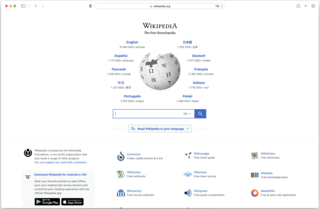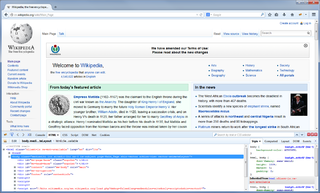Related Research Articles

A web browser is an application for accessing websites and the Internet. When a user requests a web page from a particular website, the browser retrieves its files from a web server and then displays the page on the user's screen. Browsers are used on a range of devices, including desktops, laptops, tablets, and smartphones. In 2020, an estimated 4.9 billion people have used a browser. The most used browser is Google Chrome, with a 65% global market share on all devices, followed by Safari with 18%.
This is a comparison of both historical and current web browsers based on developer, engine, platform(s), releases, license, and cost.
Mozilla Firefox has features that allow it to be distinguished from other web browsers, such as Chrome and Internet Explorer.
A browser extension is a software module for customizing a web browser. Browsers typically allow users to install a variety of extensions, including user interface modifications, cookie management, ad blocking, and the custom scripting and styling of web pages.

Firebug is a discontinued free and open-source web browser extension for Mozilla Firefox that facilitated the live debugging, editing, and monitoring of any website's CSS, HTML, DOM, XHR, and JavaScript.
Google Optimize, formerly Google Website Optimizer, was a freemium web analytics and testing tool by Google. It allowed running some experiments that are aimed to help online marketers and webmasters to increase visitor conversion rates and overall visitor satisfaction.

iMacros is a browser-based application for macro recording, editing and playback for web automation and testing. It is provided as a standalone application and extension for Mozilla Firefox, Google Chrome, and Internet Explorer web browsers. Developed by iOpus/Ipswitch, It adds record and replay functionality similar to that found in web testing and form filler software. The macros can be combined and controlled via JavaScript. Demo macros and JavaScript code examples are included with the software. Running strictly JavaScript-based macros was removed in later versions of iMacros browser extensions. However, users can use alternative browser like Pale Moon, based on older versions of Mozilla Firefox to use JavaScript files for web-based automated testing with Moon Tester Tool.

Web development tools allow web developers to test and debug their source code. They are different from website builders and integrated development environments (IDEs) in that they do not assist in the direct creation of a webpage, rather they are tools used for testing the user interface of a website or web application.

A site-specific browser (SSB) is a software application that is dedicated to accessing pages from a single source (site) on a computer network such as the Internet or a private intranet. SSBs typically simplify the more complex functions of a web browser by excluding the menus, toolbars and browser GUI associated with functions that are external to the workings of a single site. These applications are typically started by a desktop icon which is usually a favicon.
Google Chrome is a cross-platform web browser developed by Google. It was first released in 2008 for Microsoft Windows, built with free software components from Apple WebKit and Mozilla Firefox. Versions were later released for Linux, macOS, iOS, and also for Android, where it is the default browser. The browser is also the main component of ChromeOS, where it serves as the platform for web applications.

Private browsing is a privacy feature in some web browsers. When operating in such a mode, the browser creates a temporary session that is isolated from the browser's main session and user data. Browsing history is not saved, and local data associated with the session, such as Cookies, Web cache, are cleared when the session is closed. These modes are designed primarily to prevent data and history associated with a particular browsing session from persisting on the device, or being discovered by another user of the same device.

Chromium is a free and open-source web browser project, primarily developed and maintained by Google. This codebase provides the vast majority of code for the Google Chrome browser, which is proprietary software with additional features.

Chrome Web Store is Google's online store for its Chrome web browser. As of 2022, Chrome Web Store hosts about 123,000 extensions and 29,000 themes.

Chrome Remote Desktop is a remote desktop software tool, developed by Google, that allows a user to remotely control another computer's desktop through a proprietary protocol also developed by Google, internally called Chromoting. The protocol transmits the keyboard and mouse events from the client to the server, relaying the graphical screen updates back in the other direction over a computer network. This feature, therefore, consists of a server component for the host computer, and a client component on the computer accessing the remote server. Chrome Remote Desktop uses a unique protocol, as opposed to using the common Remote Desktop Protocol.

Google Sheets is a spreadsheet application included as part of the free, web-based Google Docs Editors suite offered by Google. Google Sheets is available as a web application; a mobile app for: Android, iOS, and as a desktop application on Google's ChromeOS. The app is compatible with Microsoft Excel file formats. The app allows users to create and edit files online while collaborating with other users in real-time. Edits are tracked by which user made them, along with a revision history. Where an editor is making changes is highlighted with an editor-specific color and cursor. A permissions system regulates what users can do. Updates have introduced features that use machine learning, including "Explore", which offers answers based on natural language questions in the spreadsheet. Sheets is one of the services provided by Google that also includes Google Docs, Google Slides, Google Drawings, Google Forms, Google Sites and Google Keep.
Google PageSpeed is a family of tools by Google Inc, designed to help a website's performance optimizations. It was introduced at Developer Conference in 2010. There are four main components of PageSpeed family tools: PageSpeed Module, consisting of mod PageSpeed for the Apache HTTP Server and ngx PageSpeed for the Nginx, PageSpeed Insights, PageSpeed Service, and PageSpeed Chrome DevTools extension. All of these components are built to identify the faults in a website's compliance with Google's Web Performance Best Practices, and automate the optimization process.
Credential stuffing is a type of cyberattack in which the attacker collects stolen account credentials, typically consisting of lists of usernames or email addresses and the corresponding passwords, and then uses the credentials to gain unauthorized access to user accounts on other systems through large-scale automated login requests directed against a web application. Unlike credential cracking, credential stuffing attacks do not attempt to use brute force or guess any passwords – the attacker simply automates the logins for a large number of previously discovered credential pairs using standard web automation tools such as Selenium, cURL, PhantomJS or tools designed specifically for these types of attacks, such as Sentry MBA, SNIPR, STORM, Blackbullet and Openbullet.
Google Lighthouse is an open-source, automated tool for measuring the quality of web pages. It can be run against any web page, public or, requiring authentication. Google Lighthouse audits performance, accessibility, and search engine optimization factors of web pages, this is the major difference from Google PageSpeed, the Google Lighthouse provides more detail information. It also includes the ability to test progressive web applications for compliance with standards and best practices. Google Lighthouse is developed by Google and aims to help web developers, the tool can be run by using Chrome browser extension or by using terminal (command) for batch auditing a list of URLs. Google's recommendation is for using the online version of Page Speed Insights as of 15th May 2015.
The DeGoogle movement is a grassroots campaign that has spawned as privacy advocates urge users to stop using Google products entirely due to growing privacy concerns regarding the company. The term refers to the act of removing Google from one's life. As the growing market share of the internet giant creates monopolistic power for the company in digital spaces, increasing numbers of journalists have noted the difficulty to find alternatives to the company's products. Some projects, such as ungoogled-chromium, primarily distinguish themselves from Google-maintained products by their lessened dependence on the company's infrastructure. It can be seen as part of a broader opposition to big tech companies, sometimes referred to as "techlash."
References
- ↑ Cimpanu, Catalin. "Google launches VisBug, a Chrome extension for point-and-click web design". ZDNet. Retrieved 2020-12-04.
- ↑ "Le projet VisBug de Google permet l'édition de pages web depuis Chrome". BDM (in French). 2018-11-13. Retrieved 2020-12-04.
- ↑ "Google выпустила инструмент для "чайников" в веб-дизайне". TAdviser.ru. Retrieved 2020-12-04.
- ↑ "VisBug - Hover inspect in the browser". portalZINE NMN | Development meets Creativity. 26 February 2019. Retrieved 2020-12-04.